Driving into the Blue Ridge Mountains, the world around you changes. Not just in the landscape, which becomes jagged and more dramatic the deeper you weave into the forest, but in the thick air, the color gradient, and atmospheric sounds humming from deep within the woods. In early June, the humid clouds hover above the peaks, dense with lush hues of emerald and moss. With the windows rolled down, cicadas and tree frogs murmur a syncopated rhythm so melodic that it sounds rehearsed. The mountains seem so brimming with life that if I’d told you this area was decimated by a hurricane less than a year ago, you might not have believed me. I would understand if you didn’t believe a word of it.
I packed up the van to visit my friend Tara. Our nearly 20-year friendship has ebbed and flowed through phases of life, seeing each other every other year or whenever the opportunity arose. Now that I only lived four hours south of her, I took a free weekend to check in on an old familiar face: “I want to have a classic Asheville weekend,” I’d told her, “with hiking and breweries and art in any form.” I tried not to wonder how much had changed in the past three years, let alone the past nine months since Hurricane Helene. She replied that she’d see what she could do.
On the drive north through Georgia and into North Carolina, I was reminded that, although the former is now my home, the latter had been my childhood. I listened to familiar banjo strums of Megafaun crooning “Sunlights, silhouettes, and dogwood trees, swayin’ all alone in the Carolina breeze” with the windows down, letting hot, humid air seep in atop the air-conditioned comfort. Compared to the dark forests in the rolling distance, the green surrounding the highway had recognizable patches of uniform chartreuse as kudzu blanketed trees, poles, open fields, and the occasional dilapidated building.
Kudzu is the vine that ate the south. It was first introduced as a shade ornamental from Japan, perfect for hot southern houses. It moves in quickly, as much as a foot in one day, in search of bright sun and wet air, thriving at the outer rim or recently cleared forest. To be fair to kudzu, it does create a canopy of shade extremely well, obscuring otherwise desolate landscapes with lush greenery and choking out whatever plants remained. It moves into abandoned farms and decimated ecosystems like a carpetbagger, eager to take over what lay unattended.
As I drove the winding highway into Asheville, dark clouds began to gather in an otherwise blue, pillowy sky. One big drop of rain hit my windshield. Then another. I rolled up my window and turned the music down, convinced it would help me focus on the growing traffic. The sky darkened quickly under storm clouds rolling over the not-so-distant peaks. The temperature dropped nearly ten degrees. More raindrops and I increased the speed of my windshield wiper. Only a few exits from Tara’s place, cars slowed on the curvy highway and turned their hazard lights.
Then it poured. Torrentially, sideways, and without warning. I took the exit.
Tara came to meet me in her parking lot with an umbrella. By the time I hopped out of the driver’s seat to hug her, the umbrella was almost unnecessary as the sky had already begun clearing. Had I blinked and missed the worst of it? Her mane of curly dirty blonde hair whipped around into my face and she helped me gather my things. The whiplash of a bright sky seemed to awaken every cicada in the woods just beyond her apartment complex, which began screaming in unison. We crunched past exoskeletons on our way to her unit and escaped the biological chaos in the air conditioned living room.
Once settled, we convened to make plans for the weekend. “Before we start, I have to tell you something,” Tara began. Knowing each other for two decades, I felt I knew what was coming. I braced myself for a breakup, or news that her department at the VA had been cut, but she told me something much worse. “Mavi died three days ago.” Her sweet, 13-year-old Aussie had lived with her until recently, when shifts at the hospital became too time-consuming, and lived out his elder life with her parents. With teary eyes, she told me the unsettling details of that night, with particular sadness for what her parents had to go through.
“We don’t have to do anything, if you don’t want,” I offered. “I’m happy to just watch a movie here or whatever you want.”
She shook her head, “No, let’s get out. I’ve been crying for days.”
We gathered ourselves quickly, suddenly aware of how short the trip would be. As much as grief needs time to sulk, it also needs space to recklessly expand.
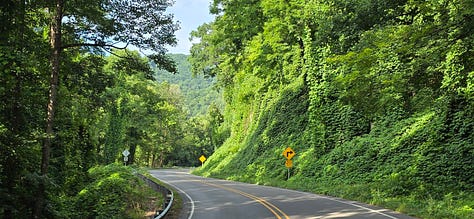

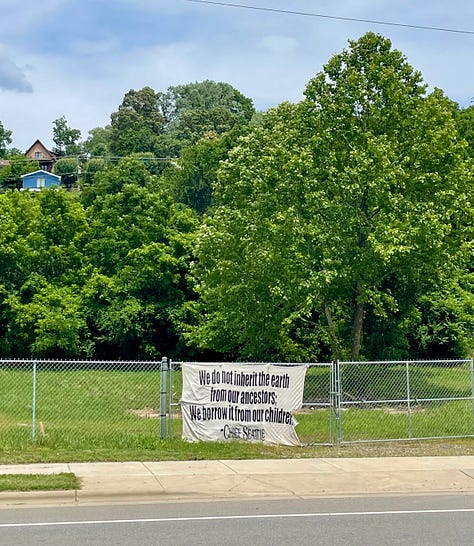
Tara joined a line of Subaru hatchbacks parked at an angle on a busy street in downtown Asheville. With a few hours to kill before a minor league baseball game that evening, we wandered the bustling sidewalk for a place to get a drink. A young man with a newsboy cap and guitar stood on the corner strumming along to a Bob Dylan song. He reminded me of my older brother Evan, who I imagined standing there himself playing the mandolin as if back in college. We looked for a rooftop bar; one we’d been to before, but weren’t still sure existed. Opting for efficiency, we entered the first bar advertising a rooftop with a view. The doorman greeted us with an open door and a compliment to my hat, which I tipped in his direction as we entered the lobby.
On the roof, we simultaneously ordered Pimms cups and walked out to the terrace. In the bright blue day, the view of the mountains stretched in every direction. Cascades of blue extended out beyond the green canopy of the city. As I took a sip of a drink I hadn’t ordered since 2014, I thought aloud, “Have we been here before?”
It was difficult to recall if this was a familiar view or a common one. Tara examined the vantage point and scrunched her face, “Honestly? I have no idea.” Relative to some of the oldest mountains in the world, it was hard to gauge what about Asheville was unchanged through the decades I’d known it. “The inside looks different, it’s cuter.”
After chatting for an hour and befriending a group of women next to us, we learned that yes, it was the same location we’d been years before. It was no longer Sky Bar, but it served the same Pimms cups. We offered them the rest of our unfinished olives and headed to the next stop.
Out on the street, we walked past restaurants full of people listening to live music and day drinking on a Friday afternoon. Rounding the corner, I saw the Urban Outfitters sticking out among the local hippie gift shops and boutiques. “My brother loves to say that’s when Asheville was over,” I said pointing to the chain building.
“Really?” she furrowed her brow. “How long had he even lived here?”
We spotted a sign for “the best espresso martinis in Asheville” at the same time and set our focus in its direction. “Must’ve been 2007.”
Crossing the street, we walked confidently into the bar perfectly popular with just one table for two available. As the tattooed bartender shook and poured two coffee-colored froths into delicate coupe glasses, he made eye contact with me. I ordered, “two more espresso martinis, please!” He half-smiled, rolled his eyes, and finished the two in his hand.
Seated at a table next to an open window, drinking truly the best espresso martini I’ve ever had, Tara continued her skepticism, “I guess my point is, how long had he lived here before it was over?” Two details about Tara in high school are that she used to work at an Urban Outfitters back home in Raleigh, and that she used to love my older brother.
The martini was perfectly sweet and clearly used a real, fresh shot of espresso. It was the exact balance needed for a second drink before 4 pm in your 30’s. In the tall yet intimate space, Tara and I talked about life; about her dog Mavi; about silly memories from high school; about the hurricane; about our parents and siblings; about the espresso martinis. We talked about everything that had changed and everything that needed to change. Echos of conversations reverberated up the two-story wall of liquor and out the window, dissipating into the street.
Closing out the house, I posited an explanation from earlier, “Maybe it’s less about Asheville being over, and more a symbol of when it was over for him.” I took the last sip of martini like a shot before finishing, “Maybe that’s what anyone means when they say their town is over.”
After dinner, as we walked down another hill towards the baseball stadium, Tara suggested one more stop before the game: “Let’s grab something from this head shop.”
I followed her and asked, “Is weed legal here?”
Holding her phone up to navigate, she replied, “Nah, not really.”
It was a typical head shop: cheap paraphernalia like lighters and rolling papers up front with increasingly elaborate glass bongs through the back. The kid working, early-20s with a scraggly goatee and squinted eyes, stood up to greet us as we walked into the empty store, his chill demeanor in stark contrast to our bumbling giggles.
We chatted with him as I tried to understand what exactly we were buying. In the twenty or so states that I have legally purchased recreational marijuana, none of them required the knowledge needed to understand the chemical or legal structure of its existence. A loophole in the law differentiated THC-A from Delta-9, but was still somehow different from “real” weed. But it was real, kind of. Just not real enough to be legal, maybe.
“Well, it’s like how green tomatoes are just unripe tomatoes; these plants are just premature.” It made no sense to me. I bought a fake weed vape anyway.
As we continued yapping away in the empty store, I kept asking him questions. This time not about the legal loophole. I told him that we’d just been discussing the moments that locals felt that Asheville was “over.”
“Man, I been here all my life,” he told us proudly. “I guess, for me, it’s like, hmm, big moments that felt like the city changed? I think for me, it’s when they took down the obelisk.”
The 75-foot granite obelisk stood prominently in downtown Asheville, like a miniature Washington Monument. It honored Zebulon Vance, a North Carolina Governor during and after the Civil War. Erected in 1898, the figure had always been controversial, not just because the governor owned slaves, but due to his rumored involvement with the KKK. In 2008, the NC General Assembly formed a committee to assess the historical context of Confederate statues in the state and for six years, they pushed not to tear it down, but to add a memorial recognizing the region’s Black history with another statue, or at least a plaque. Their proposals were ignored. In 2015, frustrated activists spray-painted “Black Lives Matter” in red. Following the deadly 2017 protests in Charlottesville, the city again promised a review—then did nothing. Only in 2020, amid nationwide and local George Floyd protests, was the monument finally removed, despite a lawsuit from a Civil War reenactment group. Had leaders acted on the original call to contextualize it two decades ago, not erase, it might still be standing.
“It was just so iconic that it was, like, wow, okay, that’s gone. Asheville is gone.” I nodded along without questioning how he’d felt about its origins. It didn’t seem to matter to him; what mattered was a landmark of his city was gone. His Asheville died in 2021, and I wondered who he blamed.
I asked him another question: “What do you think will happen now?”
He raised his eyebrow as if assessing my interest. “How deep do you wanna go?” he asked back.
Tara stoked him on, “We wanna know what you think about the flood. Like, what do you think will happen now?”
“I think, it’s like the 9th Ward during Katrina. I think they flooded out the poor people, man.” He didn’t look agitated or suspicious, as I’d expect a born-and-bred hillbilly hippie starting a rant to be. He explained that the floods only happened where poor artists live; that developers would be quick to move into the abandoned spaces; that the government was clearing out people to mine minerals; that the Biden Administration wanted to stop people from voting; and that there were still thousands of missing people. “It’s disaster politics, just like Katrina.”
A particular nerve is stuck in me whenever someone evokes the storm’s name. “The storm,” as anyone in my family or friends around New Orleans called it, felt incomparable by any standards. It was during the storm that my own mother stopped watching the news altogether, as it “never provided any useful information” about if our loved ones were okay, offering only “fear, sadness, and hours of unsolvable problems.” She still doesn’t watch the news.
My guess was that by “disaster politics,” he was referring incorrectly to Naomi Klein’s Shock Doctrine. Her brilliant 2007 book argues that powerful people manufacture chaos after a disaster or war to push through extreme policies that benefit corporate interests while harming the disenfranchised. A complicated nuance I see in the book is what is considered a “man-made” disaster. Hurricane Katrina itself was not man-made: but the increase in global temperatures that caused it was, and the conditions that led to the worst flooding in the 9th Ward were, and the policies that allowed private military police including Blackwater to harass locals were, and the long-term decisions like leaving destroyed schools to become abandoned and replaced with charter schools were, too. If all of those other elements had been man-made, was it really so crazy for this guy to think of the hurricane itself as man-made, too?
I had a thousand follow-up questions that I tried to raise without derailing down the wrong rabbit hole. He was correct that flooding happened in poor areas, but that was due to bad infrastructure development and systemic wealth disparity; why would developers rush to move into places that were flood-prone? And yes, there were massive deposits of quartz in the area, but they were already being mined, and wouldn’t damaging the region only harm the supposed perpetrators? And yes, the damage and chaos did prevent people from voting, but if the Democrats caused the storm, why would they target Asheville, a known liberal stronghold? If a hurricane was man-made, why would someone manufacture an outcome so inconsistent?
But I didn’t poke holes in his rationalization; logic can sound a lot like cruelty to someone grieving. As for the thousands of people missing… that, I had less insight into. “A thousand is a lot for this area. Do you personally know anyone that’s still missing?”
“My buddy works with a guy who didn’t show up one day, we think he’s missing.” Just then, another man walked into the shop and our friend had to continue his job. “Sorry, ladies, let me know if you need anything else.”
We thanked him and I added, “I hope they find your buddy’s coworker” as we walked out the door.
Vapes in hand, we confidently walked to the minor league baseball stadium down the street, nearly an hour late. But something was off: crowds of people were leaving midgame. Tara was determined to get a free jersey, so we continued to the gates as rain started to fall. At the entrance, they explained that there was a rain delay but we were welcome to go in anyway. “I doubt they have jerseys left, but they haven’t called the game yet.”
We found open seats under the awning portion of the small stadium to witness one whole inning before they paused again and covered the field in a white plastic sheet. The minor league team had once been called the Moonshiners, then the Mountaineers, before landing on their true identity: the Tourists. Little kids in ponchos ran around in the uncovered portion, anxiously awaiting the game to resume. Tara and I continued to drink cheap beer and vape as the staff attempted to hype up the bystanders with “Sweet Caroline.” After half an hour, with puddles forming on the covered field and trees swaying more aggressively in the wind, the game was called.
The rain won. Again.


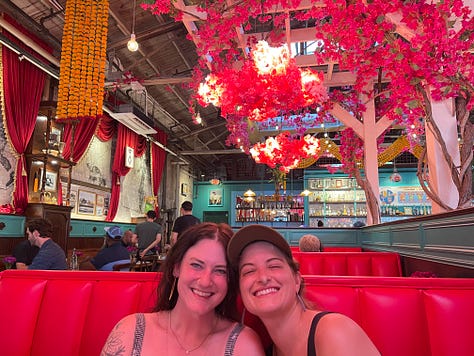
The next morning, I wanted to go on a hike. Tara rattled off options as I looked them up on Google maps. Most of them were nearly an hour away. “It’s funny,” she said, “for as nature-loving as Asheville is, there isn’t much nature actually in Asheville.”
“What about these, up in Pisgah National Forest?” I asked.
She didn’t even need to look at them to respond, “No, most of those are still closed. And the ones that aren’t get pretty busy midday.”
I sighed, then coughed. “Please throw all of the vapes away,” I choked. “Never again.”
Tara confirmed they were in the trash before I’d asked. “We could go to the Biltmore,” she suggested. “They have lots of walking trails and nature to see around the house. I even have a guest pass I got for when my parents visit, they love it so much.”
It had never occurred to me to visit the Biltmore, despite all the times I’d heard its name in commercials and on buildings across the city. I knew it was a huge house with gardens and trails, and I knew that you had to pay, so I never bothered. Considering the free offer I wondered, “Who even are the Biltmores?” aloud and to my phone, only to hear it the second it left my mouth. “Wait, bilt? Like, Vanderbilt? Am I an idiot for not knowing this?” I immediately opened my phone to investigate.
The 8,000 acre property just south of Asheville including the house, a conservatory, a winery, and horse stables seemed to have been largely unscathed by the hurricane. The Vanderbilts’ country home - the largest privately owned house in America - was open to tourists. Before reading too much and spoiling the details, I put my phone back down.
“I changed my mind,” I told her. “I want to tour the house.” So we went after breakfast.
We drove south along the French Broad River, lined with empty lots and railroad tracks. Tara pointed where White Duck Taco used to be and I sighed that I used to love that place. One warehouse still standing warned “Looters will be shot” while another called out a “Black Ford Ranger!!! On camera!” But most notably, the empty lots and abandoned buildings were obscured by a layer of thick kudzu and other green weeds, reclaiming space through cracks in the concrete.
Kudzu was adopted by the federal government as subsidized erosion control in the 1930s. Much like the Dust Bowl of the Great Plains, the southeast suffered its own soil crisis from centuries of monoculture cropping, clear-cutting native plants, and overworking the land for maximum short-term yields. Cotton and tobacco farming were already in decline before the Civil War started due to these poor practices. As a part of the New Deal, farmers were paid to plant 500,000 acres of kudzu for erosion control and cattle fodder, or paid to retire their land from agriculture and move. Unlike the Great Plains, kudzu thrived in the humid south and continued to sprawl as farmers abandoned their exhausted land. Quietly, the federal government walked back its promotion of the plant until it was formally deemed a “pest.” It was too late as millions of acres of the southeast had been completely taken over, and the federal government was unable to fix the problem it created; it could only help to mitigate it going forward.
“Honestly,” Tara said, “this looks so much better than it did earlier this year. Even two months ago, it was still bleak.”
We continued driving into the River Arts District, where a density of breweries, art galleries, and other quirky spaces had been destroyed – that is, depending on which side of the railroad tracks they’d been on. East of the tracks were hilly, and seemed, nine months post-storm, to be fairly unscathed. West of the tracks was a small strip of low-lying land next to the river, where water pooled upwards of 25 feet and completely wiped out entire businesses. The discrepancy in damage is so clear that I understand why someone would feel it was targeted. But not by some recent plot by the federal government; by dozens, maybe hundreds, of policies and sentiments over the decades.
First and foremost, the River Arts District (RAD) was Cherokee land. After settlement drove the native population out, the railroad brought industrial factories, mills, and stockyards – until 1916, when a massive flood destroyed businesses, or if they were wealthy enough, relocated them to higher ground on the east side of the tracks. Given the area was cheap and undesirable, it became one of few, close-knit communities of Black livelihood with a cohesive density of Black-owned businesses, homes, and churches in the Jim Crow south – until 1968, when urban renewal programs designated the neighborhood a “slum” that Ashevillians voted to tear down, scattering Black residents into unwelcoming neighborhoods with Section 8 vouchers and redevelopment policies. There, in the wake of natural and human-made destruction, is when the artists moved into the arts district, each iteration of community shorter-lived than the last.
The entrance into the Biltmore Estate requires a drive through the Biltmore Villages, another neighborhood still in ruins from the flooding. Unlike the RAD, these buildings weren’t industrial but rather… cute? Tudor-style huts with half-timbered facades and pitched roofs were boarded up along the whimsical stretch of gift shops and galleries. Even the McDonald’s was picturesque and on-theme, as if in a Disney World food court. “Who lives here?” I asked Tara in confused wonderment.
“The workers,” she said as she slowed the car down to enter the grounds through a massive brick gateway, the only part of the property under repair from the storm.
“The workers of what, the house?” I asked. We reached the summit and drove past the open, pristinely trimmed lawn leading directly to the castle, the manor, the estate. “Oh, so not just a house.”
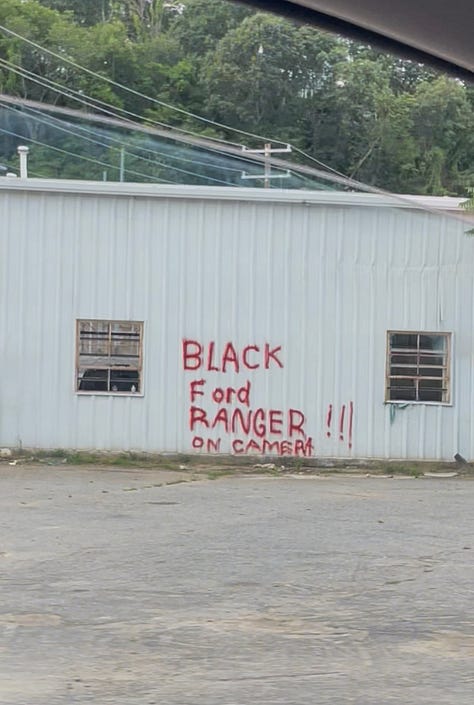
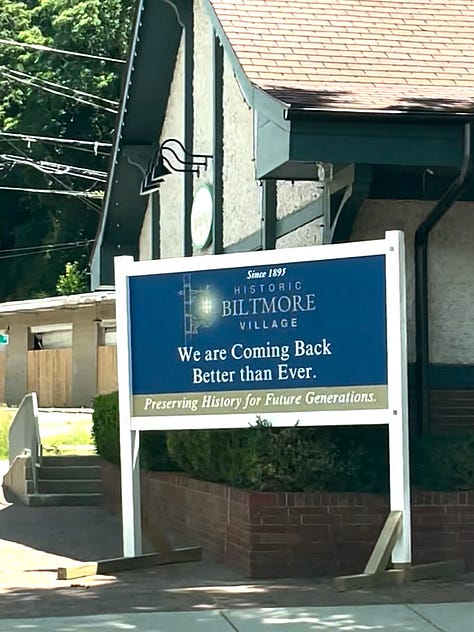
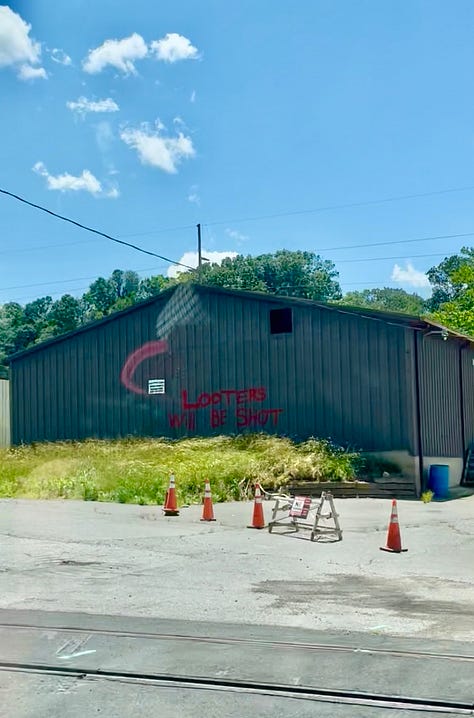
It was impossible to see a bad view from any vantage point of the Biltmore Estate. The Blue Ridge Mountains cascaded off in either direction, high above the river basins. As we approached the house, details of the unbelievably ornate exterior came into view: carved spires that led four stories tall, oxidized copper rooftops with bright green peaks, and gargoyles perched at the corners as if it were a cathedral. A long railing protected the home from the masses and created a line for those willing to purchase an $80 ticket (or their free-loading friends). The courtyard past the security entrance sold baked goods and ice cream as if it were a perennial Christmas market. I couldn’t fathom how many people were working there to maintain the sheer quantities of ticketed and paid experiences. Finally, after needing to consult with multiple box offices, we finally entered the house and began the audio tour.
The first person to be called a “robber baron” was Cornelius Vanderbilt. The New York Times described him this way because by 1859, he had already dominated the steamboat industry in New York through hostile takeovers, price manipulation, and exploiting (or outright ignoring) weak regulation. He worked within the loopholes of a patchy government while also paying them off with war ships for the Union Army. After the war, he used his wealth to purchase and consolidate railroad companies into mass transit conglomerates. When he died the richest man in America, he left 95% of his fortune and empire to his oldest son, who himself died less than a decade later, leaving that wealth (which had doubled in eight years) in the hands of his children, including his youngest, George Washington Vanderbilt II. And the grandson of the robber baron wanted a sick bachelor pad.
The house inside was immaculate. A perfectly preserved shrine to the Gilded Age. The massive glass atrium led into a billiards room fit for a Clue murder. The three-story dining hall could fit 26 chairs, three connected fireplaces, and more animal heads than I could count. Renoir paintings covered the servants’ entrances in various parlors to keep partygoers entertained enough to not notice the help. The library, straight from Beauty and the Beast, contained so many leather-bound books that I imagined it to be its own proto-internet, where any piece of information could be found with a little digging. “George loved to host intellectual elites in his country estate,” the audio tour explained. “An ideal space for entertaining guests as an introverted bachelor.”
Most of the rooms were shrouded in curtains to prevent sun damage to the delicate antiques. But whenever I could peek out a window, the view of the landscaping and surrounding mountains took my breath away. Though the Vanderbilts had commissioned mansions in Rhode Island, Massachusetts, and of course, New York, the youngest son decided on Asheville for its scenery and supposed health benefits from fresh air and trees. He bought 125,000 acres of land, comprising 700 farms and at least five cemeteries, including the Black community of Shiloh. Money was no object to paying off the farmers, many whose lands had been degraded from monocropping and systemic slavery; but he still had to convince each of them to move down the other side of the hill to make way for his country home. From that hill, his special hill, from any room, I could see for miles, assuming I could glimpse from behind a curtain.
The tour continued from the ornate bedrooms and entertainment spaces of the first four floors into the basement. A secondary world of narrow hallways and unseen staircases organized the servants’ quarters, where dozens of employees scurried about to cook, clean, and tend to the Vanderbilt family. A massive room dedicated to laundry machinery and another entirely for arranging flowers. There were also rooms for health equipment - a gym, a pool, and a bowling alley - but servants were often required there as well to reset bowling pins or hand George his towel. The audio tour pointed out multiple times that the workers were always paid, and that some “even lived in their own homes in town.” The town being Biltmore Village, still closed from the floods. The whole Biltmore Company, including the property’s multiple hotels, multiple restaurants, winery, shopping, and full slate of activities, is still one of the largest employers in the region. If the village floods, the estate will just fix it back up.
Rounding out the tour, Tara suggested we take a longer walk back down to the car on a path through the field. George clearly spared no expense or connection to building his dream park. Frederick Law Olmsted, the visionary landscape architect responsible for Central Park (which also required the demolition of a Black community to build), was hired to design the grounds. Gifford Pinchot was hired to manage the forest years before he would help create and become the first head of the National Forestry Service. Just before his death, George sold 87,000 acres of his beloved land to the federal government to become the basis for Pisgah National Forest, enshrining his legacy as a pillar of the conservation community forever.
He only did this, though, in anticipation of the passage of the Sixteenth Amendment, which would usher in astronomical income and estate taxes on his incredible wealth and property. His widow Edith later consolidated their estate even further by selling land and Biltmore Village to various public and private entities. Like the glimmer of a copper roof fading into green, so, too, did Gilded Age opulence tarnish from gold to rust. Only a few descendants remained in the cavernous mansion. During the Great Depression, the City of Asheville asked the Biltmore Estate to open its house and remaining park land to the public for the first time in hopes of generating tourism, the thing that had brought the Vanderbilts to North Carolina in the first place. It has been the main draw and developer behind Asheville since.
On our walk, the grass was perfectly pastoral green and dotted with well-kept oak trees like a neo-impressionist park; I envisioned women in bustle dresses and parasols strolling by with picnic baskets. I took a deep breath of mountain air, filling my lungs with humid air and raised my hands to block the sun from my face.
It was a perfect park. Not a patch of kudzu in sight.
We finally arrived back at the car and blasted the air conditioning. As we exited the theme park down a winding road, I didn’t know what to think. I watched the hordes of tourists traipsing along the French Broad River on the sunny summer day, walking, biking, and riding horses along the rolling fields. I couldn’t deny the number of people taking advantage of the cloudless day and well-funded, well-managed park, even if they had to pay to be there. After all, the public park next door was still closed.
“That was, like, if our descendants paid to visit Elon Musk’s grandchild’s summer home,” I laughed. “It’s beautiful, but isn’t it bizarre?”
Driving past a shimmering lake, Tara ignored my comments and swooned, “My parents used to love taking Mavi here.” I stopped insulting it.
Later in the evening, as golden hour began to cool off the day, Tara took me to a free production of Shakespeare in the Park. “Finally,” I said, “an actual free park!” A traditional wooden stage sat at the bottom of a slightly steeped hill; the view behind the stage would have been of neighborhood homes, save for the kudzu obscuring them like a curtain.
We found a place in the back to set up chairs and lay out a blanket. “I’m sorry I talked about Mavi so much this weekend,” she apologized. “It’s just… thirteen years. That’s as long as I’ve lived in Asheville.”
I joined her on the camping chair, resting my arm around her shoulders in a hug. What do you say to someone you love when her world has been destroyed, for no other reason than circumstance? How do you comfort someone whose loss you don’t quite understand, but you want so desperately to feel on their behalf? How could I help something that could never be fixed, only changed and moved on from? I didn’t have anything good to say, so instead, I said, “Mavi was a good dog.”
She leaned her head on my shoulder and closed her eyes. “Yeah, he was.”


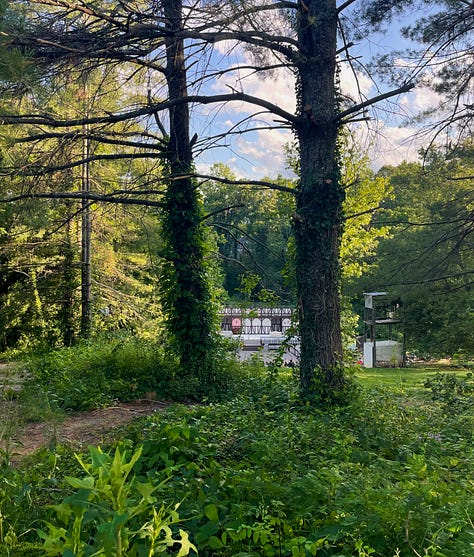
The next morning, I set off for my last day in the city, now alone. I drove to a sushi restaurant to meet Zach, an old colleague of mine who had recently moved back to the United States. He’d settled in Little Switzerland, a name I thought he was using sarcastically, to spend time with his parents after a life-uprooting breakup about a year ago. “The last time I saw you was at a rooftop bar in Nairobi!” he exclaimed as we naturally embraced for a hug. He was as tall and lanky as I’d remembered with a full-faced smile that reached up to his eyes.
We had too much to catch up on to pretend to be strangers. Have you talked to so-and-so lately? How is she doing? How did the job work out? What happened to your boyfriend? What happened to yours? How are your parents? Are you okay? Are you?
And then I asked the real question. “Is there anything crazy going on after the hurricane? Have you heard any conspiracies or, maybe, do you believe in any?”
He nodded as he finished his bite of dumpling. “People think there are thousands of unreported missing people, and the government is covering up the real death toll.”
Officially, “Helene is responsible for at least 250 fatalities in the United States (including at least 176 direct deaths), making it the deadliest hurricane in the contiguous U.S. since Katrina in 2005.” In North Carolina, 108 people died; 43 in Buncombe County alone.
I took a sip of green tea and leaned in. “So, what do you think?”
“I was out of town for the actual storm,” he began. He explained that he’d started a spreadsheet and a WhatsApp group, and used social media and forums to find posts about who was missing and who had been found. His dad could get cell service by walking up the Blue Ridge Parkway about 4 miles to the top of a mountain, stand still with his phone in the air, and wait for as many text messages to download before the service went away. Every morning, he’d hike up to download the new list of names to check, or at least as many names as he could load. Then later, when service got a little better, he could send me back names that they’d confirmed, one way or another.
It wasn’t exactly a loophole, it was more like a stopgap — something that was never meant to be a permanent fix, but had somehow fallen into significance in the holes that had been left behind. “That’s incredible. How long did that last?”
“It took the National Guard at least a week to get there. By then, the community had started responding. There were people on horseback bringing food to people on the other side of the mountain and getting them medical attention. So when the Guard showed up days later and blocked them from going back because it was unsafe, it was like, if you’re not bringing them food, get out of my way. It really did feel like the government was stopping aid.” He took a bite of sushi and paused before finishing. “But of course, it was dangerous, and if people died while the Guard was there, they would’ve been blamed for that instead.”
“So what happened to the spreadsheet?” I asked.
“Well, we handed it off to FEMA. We said, here you go, here’s a list of thousands who are missing, go find them. And then they just… never followed up.” He sighed.
“You mean they didn’t find them?”
“No no, they found them. Or at least, some of them. But it’s not like they started using our spreadsheet in some official capacity. They weren’t giving daily updates on the tool that people were using. We had to go back in and sort of haphazardly add the people we found later, just so we’d have a record, even if it wasn’t official. But no, no real follow up from the government. That’s at least one reason why some people think the numbers are wrong.”
It was a hole with no loop; no return to the source. “What do you think?” I asked.
He leaned back and took a moment to respond, the first quiet moment of lunch. “I think people still run inside when they see rain. I think what happened was really traumatic on top of everything else traumatic,” he gestured wildly around, “else out here. I think there are people who will always be missing because their bodies have been torn apart by the piles of debris and I think their families will always believe something else happened to them. And I think people process trauma in whatever way they can, including finding an enemy.”
We sat in the nearly empty sushi restaurant and finished our meal. He offered me a place to camp the van that night, but getting across the mountain was still a haul and in the wrong direction. “You can come visit the Museum of Minerals! I think it’s back open.”
“There’s a mineral museum?” I raised. “It’s not a strip mine by now?”
He rolled his eyes and teased, “Don’t believe everything you hear.” We hugged again and I promised I’d be back again soon.
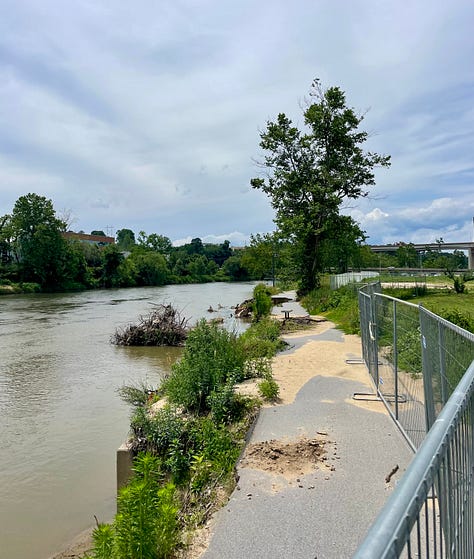
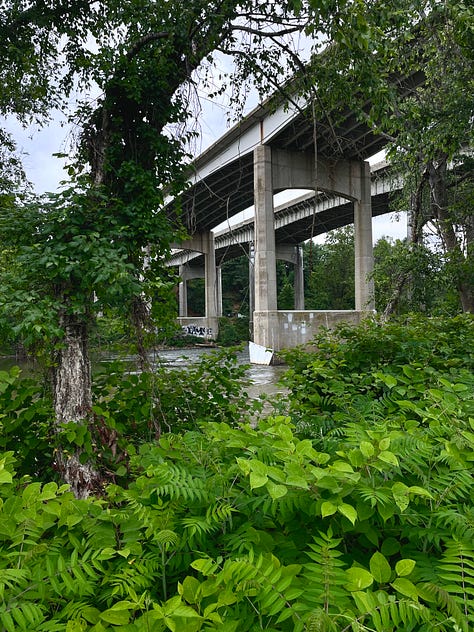
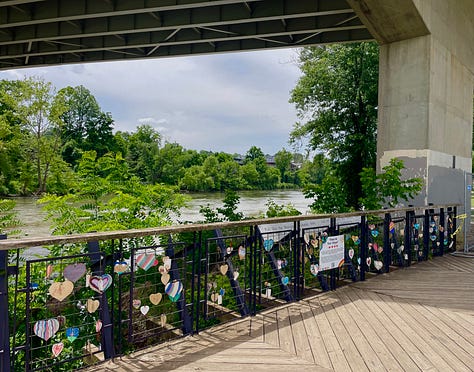
I went back to the River Arts District and walked the path along the French Broad, avoiding areas still fenced off from bank erosion and missing chunks of sidewalk. The river looked mostly cleared, save for the backdoor of a semi-truck pinched against a pillar of the underpass by the rapids. Along the greenway, a patchwork of warehouses stood in various states of repair; I walked into a brewery that advertised in bright vinyl letters WE ARE OPEN! to pick up a couple of six packs. Next to it, an industrial building with broken windows covered in kudzu stood alone; though judging by the layers of graffiti, I suspected it had been abandoned long before the storm. Had it been a tanner or an ice factory? How many cycles of commerce and community had existed there before someone painted Homer Simpson on the transom above the loading dock? How long before the kudzu engulfed that, too?
I drove across the bridge to visit the one place I knew would feel like classic Asheville to me. When my brother worked at Firestorm back in college, it was still downtown before moving to the cheaper, grungier westside. “Worked” is not the term he uses, as it was and still is an employee-owned co-op; he usually corrects me to say he was an owner. I call it the anarchist bookstore, and he doesn’t correct me on that. I picked up titles I would never see at even the most indie regular bookstore: Make the Golf Course a Public Sex Forest!; A Mass Conspiracy to Feed People; and Making Our Future: Visionary Folklore and Everyday Culture in Appalachia. On the way out, I said hi to Libertie, who’d been an owner since the original location and mentioned they’d just been emailing my brother, like no time had passed.
The rain had returned in time for dinner, so I chose a restaurant nearby I hadn’t heard of and more upscale than I was expecting. I sat at the bar, as I tend to when I dine out alone, and asked the bartender for recommendations. We got to talking about, you guessed it, the hurricane. “You know, all things considered,” she told me, “it was really cool to see people come together. My friend had this old school bus that he just started driving around, picking people up wherever he could and just bringing them where they needed to go. Honestly, it’s crazy to even think of that time. I kind of miss it, in a weird way.” After a weekend in Asheville, I was beginning to understand what she meant: that something profound had changed for everyone she knew, and no one knew whether to grieve or carry on. It was as bad as Katrina, and that I understood.
I took her recommendations and ordered a three course meal of seasonal food. I savored every bite of fresh sugar snap peas and locally-foraged mushrooms from my home state like my body was attuned to it. As the bar calmed down, we kept talking about the storm. “You know, Trump only won by 183,000 votes in North Carolina. 200,000 absentee ballots were sent out, but only 1,500 were returned. Everything else was either lost or destroyed.”
“What’s the difference between something being lost or destroyed?” I asked.
She paused. She reset. “I guess whether it was intentional or not,” she offered. I nodded knowingly, trying to encourage her opinion. “Either way, early voter registration was totally thrown off. They wouldn’t extend the October 11 deadline. It’s hard to say that wasn’t intentional.”
When I’d finished my last bite of blueberry sorbet, I thanked her for the recommendations and company. “We’re just so happy to have you here, come back and see us anytime.” I tipped her 25% and tried not to look closely at the bill.
After dinner, it was too late at night to attempt to camp. Most of the campsites I identified earlier in the day were already booked by the afternoon, and I’d been flakey to commit in exchange for flexibility. Instead, I did what felt most comfortable to me: I went back to the RAD to sleep at an underpass down by the river.
There was one other van parked to one side of the parking lot, so I respectfully parked on the other. I slid my side door open to let in the cool night air, the smell of dewey grass wafted in. Sitting quietly in the dark, I thought about the very land I was parked on. What if it crumbled out beneath me into the rushing water below? What if this place I’d decided to depend on abruptly ceased to be dependable? How would it feel if my van Clementine were completely destroyed with everything I’d worked so hard to build? What if I were in it when that happened?
Suddenly, I heard “Hey, excuse me! White van, excuse me! Is anyone there?”
I tensed up. I took my key in one hand and slowly widened the door open with the other. A man with shaggy blonde hair in his late 30s was a good distance from the van, standing with his wagging cattle dog. “Hey man, what’s up?” I asked confidently.
He took even more steps back. “Oh, I’m so sorry to bother you. I was just wondering if you had a cigarette I can bum?”
He seemed as scared as I was to approach a stranger in a van, and even more nervous when he saw me. “Nah, I’m sorry, I don’t.” I told him, stepping out to his level. I quietly cursed myself for having bought a vape and not a pack like the good old days, even better if I ended the weekend giving them all away. “I have a couple bucks though?”
His dog chased a ball and brought it back to my feet, looking up excitedly at me. He responded, “Aw, nah man, that’s nice but really, that’s a lot…” He backed up more, timid that I had offered. “But honestly, if you have some water, or just anything to drink, that would be great. I’d love some clean water.”
I grabbed an empty plastic juice bottle from the van and filled it from a cold liter of water I’d just bought. I handed him the refilled container and a five dollar bill, “It’s not much, but just take this.”
He took the bottle but hesitated to accept the bill. “Are you sure?”
I pressed it forward into his hand. “Definitely, I’m just sorry I don’t have a cigarette.”
He thanked me over and over as he wrangled his cattle dog back by his side. “Thank you for looking out for me,” he said before continuing on the sidewalk into the night.
When I left the next morning, the sun was beaming down on the river, illuminating the water to look clearer than it did the day before. Before I reached the highway, I passed a house with a big, sloped yard covered in kudzu – and goats. A herd of goats were scattered around the mass of greenery, inhaling without hesitation the gnarls of vines sprawled in every direction. Except for the already cleared patches, revealing dead spots of barren land. You’d think it were ugly if you didn’t know what it had just been through. But I’d encourage you to try to understand it for yourself, how it would feel if you were still bare in the face of unexpected regrowth. It would be at least another season before the flowers could bloom there again. I promised I’d be back before then.
A rundown of all the places I visited and recommend on your trip to Asheville:
Food and drink
Flat Iron Rooftop: Order the Pimm's cup and a bowl of olives to share
Chai Pani: Get there early on the weekend! Order the bhel puri, green mango chaat, mushroom uttapam, saag paneer, and East Indian G&T
The Times Bar and Coffee: Order the espresso martini (duh)
Crave the Dessert Bar: Good for a late night spot. Order the s’mores (it comes with its own fire for the table!) and the classic espresso martini (duh duh)
Jargon: Upscale, intimate; order the snow pea salad, mushroom and spring pea risotto, seasonal sorbet trio, and a Temporary Solution
Stoney Knob Cafe: Quirky and worth the drive north
Summit Coffee: Open, but still operating out of a trailer park at The River Arts District Brewing Company
Hi-Wire Brewing: Back open after eight months
Places and things
Shakespeare in the Park: Free all summer!
Asheville Tourists: Minor league baseball team
Firestorm Bookstore: Worker-owned anarchist bookstore
Southern Highland Craft Guild: Learn about and purchase folk art from pottery to glassblowing to large-scale tapestries
This piece was edited by my bestie Lori McCue, who has been freelance editing fresh off her long-time editing roles at The Washington Post and DCist. If you’re looking for someone to edit your book, article, or, honestly, anything else because she rules, send me a message!



